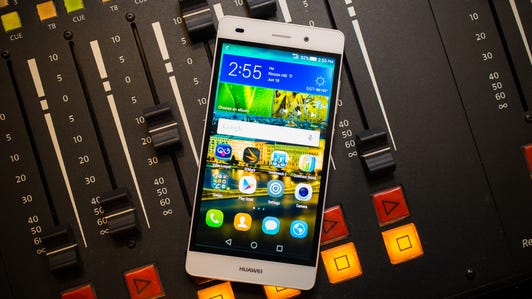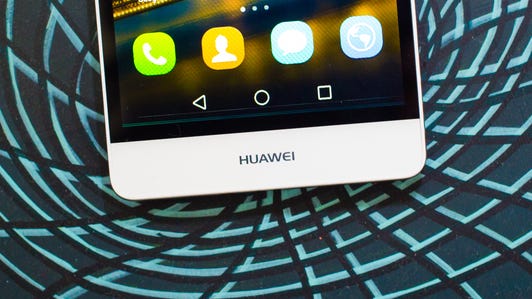
Juan Garzón/CNET
Huawei, the telecom giant you’ve probably never heard of, is getting serious about breaking out of its anonymity.
A year ago today, the Chinese company, which is the top-ranked telecommunications equipment in the world by revenue and the fourth-largest smartphone vendor by market share, opened an online store to sell its own smartphone directly to consumers in the US.
Related stories
- CNET’s first take on the Huawei P8 lite
- Huawei adds gold flair to its transforming TalkBand B2 fitness tracker
On Wednesday, Huawei ramped up its online retail presence by introducing the P8 Lite , an attractively priced midtier smartphone, as well as a fitness tracker made in cooperation with Jawbone called the TalkBand B2. It’s just the start. Zhiqiang Xu, president of Huawei Device USA, said in an interview on Tuesday that he plans to release a premium smartphone in the second half to compete with the likes of Apple’s iPhone 6 and Samsung’s Galaxy S6.
Huawei’s focus on its online sales channel is part of a broader push by several Chinese vendors to sidestep the US carriers and build their brand by directly appealing to consumers with affordable smartphones packing relatively high-quality components. The move comes as consumers grow savvier about the cost of smartphones thanks to carriers that have eliminated subsidies, revealing true prices that range between $100 and $1,000.
“The market is going to change,” Xu said about how consumers will buy their smartphones. “E-commerce is the perfect solution in my mind.”
For consumers, the result is a bounty of affordably priced smartphones hitting the market that are unlocked, or aren’t locked into a single carrier. Huawei, for instance, boasts that its P8 Lite, priced at $250 without a contract, will be able to work on any US carrier’s LTE network. Xu said he believes that the P8 Lite is good enough to sell 10 million units around the world.


Now playing:
Watch this:
Huawei P8 Lite wants to be your smartphone steal
2:08
The attitude is a departure from the traditional strategy of working with the US carriers, which have ignored the Chinese vendors’ top-tier smartphones, largely relegating the likes of Huawei and ZTE to fill out the portfolio on the prepaid or budget side.
Huawei’s Xu hopes to build a little momentum through word-of-mouth buzz.
“It only takes one or two blockbuster phones to change the whole scenario,” he said.
A limited market
The likelihood of a blockbuster birthing out of the online market, however, remains limited. In the US, a vast majority of consumers still purchase their smartphones directly from the carriers, or a retail partner acting as an agent for a specific carrier.
In the three months ended in April, only 26 percent of smartphones were sold online versus at physical stores, according to Kantar WorldPanel. That number includes online carrier sales too, meaning online sales of unlocked devices represented an even smaller slice of the pie.
“Online as you can see is still a relatively small part of the market and the type of consumers who turn to online tend to be more price sensitive consumers looking for a deal,” said Carolina Milanesi, an analyst at Kantar.
A notable exception is Google — it made a splash a few years ago with its Nexus 4 smartphone, which it sold online at $350 without a contract. Still, with last year’s Nexus 6, the Internet search giant opted to also work with carriers to ensure it had more retail support.
Huawei’s sleek P8 Lite takes a stab at budget style (pictures)






That hasn’t stopped players like Alcatel, which set up an Amazon-powered store earlier this year, or ZTE’s own US store.
While he believes the online push is the right direction, Xu said he couldn’t predict when US consumers would start taking unlocked smartphones more seriously. The carriers are helping educate consumers. AT&T confirmed on Monday that it was pushing its retail partners to eliminate the option to offer contracts and phone subsidies, instead relying on a non-contract option like the carrier’s monthly payment program.
To raise awareness for GetHuawei.com, Xu said the company planned on making a push for more digital and social marketing. He said he was still thinking of more traditional means of marketing, including big sponsorships or flashy television commercials, which tend to be more costly.
Huawei is attempting to alleviate the concerns around buying an unlocked smartphone by offering a two-year warranty on the P8 lite, as well as offer a monthly installment program split between three to 12 months.
“You can’t find a better deal on Earth,” Xu said about the P8 Lite.
The other leg
Just because Huawei is pushing its own retail strategy doesn’t mean it’s abandoning the carriers. While Huawei will lean on its own online presence to build its own brand, it will also still work with the carriers to sell smartphones through the traditional channels.
Even with the company’s planned premium smartphone in the second half, Xu said he preferred to partner with a carrier in addition to offering the device on its own website.
The high-end smartphone segment is brutally competitive without carrier support because it is dominated by well-established brands armed with hefty marketing budgets.
“We are not a well-built brand,” he said. “That a reality for us.”
The Xiaomi way?
While Huawei and other vendor bulk up their retail websites, there’s already another Chinese company making waves with its online presence: Xiaomi.


Asa Mathat for Recode
Unlike the other vendors, Xiaomi has built its retail presence almost virtually all online, and directly to consumers, building a growing base of what the company calls its “fans.” The result: Xiaomi is the world’s most valuable startup as investor bet on continued rapid growth in the key smartphone business.
Xiaomi is slowly edging into the US market, having officially launched its online store here. But the store only offers accessories like headphones for now.
“We don’t have a set plan,” Huge Barra, global vice president of Xiaomi, said at the Recode Code conference last week. “We haven’t picked a date to bring a smartphone to the US. We’re sort of dipping our toes.”
Xu said Huawei has seen its own success online in its home market of China, and doesn’t believe his company is attempting to emulate Xiaomi’s success.
“I would not say it’s the Xiaomi way, but it’s the way of the future,” Xu said.



